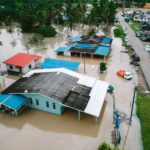 Hurricane Helene exposed the rising threat of extreme weather and the damage caused by severe flooding. A recent study reveals that public housing in America is especially vulnerable, with many residents living in areas at high risk of flood damage.
Hurricane Helene exposed the rising threat of extreme weather and the damage caused by severe flooding. A recent study reveals that public housing in America is especially vulnerable, with many residents living in areas at high risk of flood damage.
Researchers from Ohio State University and Texas A&M University examined public housing inspection scores from the Department of Housing and Urban Development (HUD), flood maps and risk data from the Federal Emergency Management Agency (FEMA), and demographic information from the American Community Survey.
Risk inequality
The study found that lower-quality public housing—those with poorer inspection scores—tends to be located in FEMA flood zones and other areas with high flood risk. These homes are more likely to house people of color and others already facing social and economic challenges.
“Residents with the least resources to recover are the most likely to face serious damage from flooding,” the researchers concluded.
FEMA defines flood zones as areas at risk of flooding from rain, storms, or dam overflows. Homes in high-risk areas, where there is at least a 1% chance of flooding each year, are required to carry flood insurance if they have federally backed mortgages.
But Hurricane Helene showed that flood damage can extend beyond FEMA’s maps. In Asheville, North Carolina, most of the damaged properties were outside official flood zones. Many low-income residents, especially those in mobile homes, were among the hardest hit.
As climate change brings stronger storms and more frequent flooding, the study’s authors call for action to protect public housing in flood-prone areas. Without such steps, the most vulnerable communities will continue to bear the heaviest burden of extreme weather.